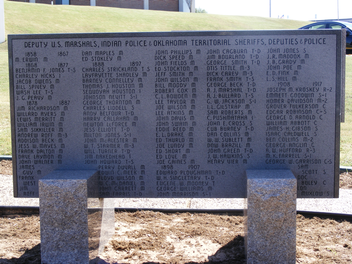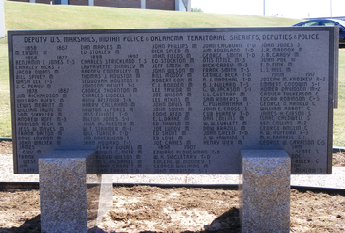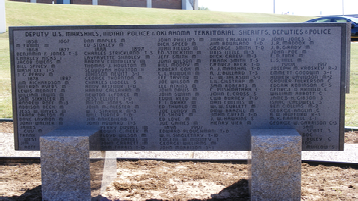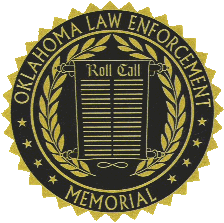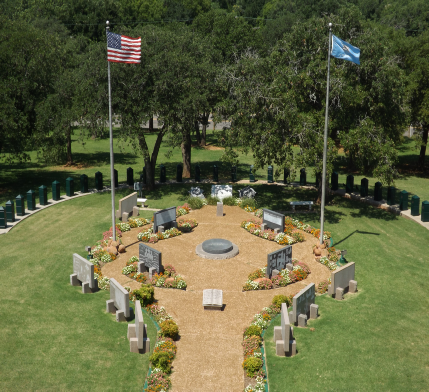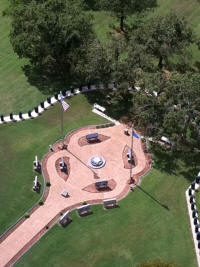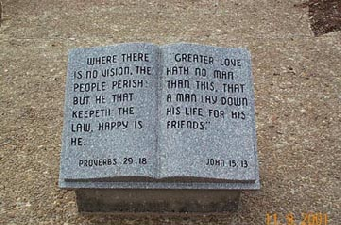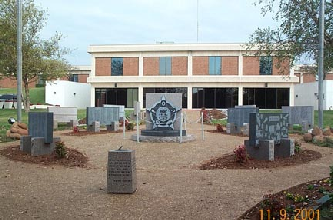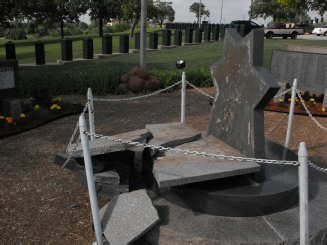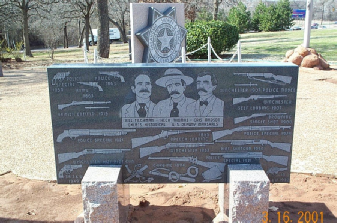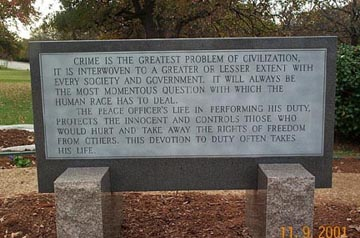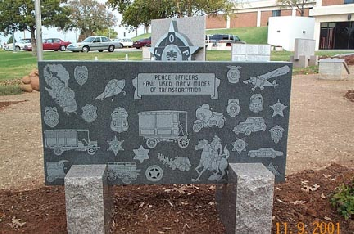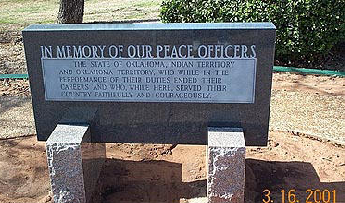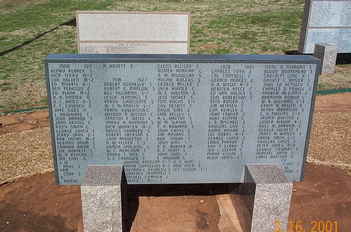


The Oklahoma Law Enforcement Memorial Ariel View
The Oklahoma Law Enforcement Memorial is located on the west grounds of the Department of Public Safety Headquarters at 3600 Martin Luther King Avenue, in Oklahoma City.
The Oklahoma Law Enforcement Memorial was the first permanent memorial built in the United States to honor all of the fallen officers of a state. The Memorial was four years in the planning and construction. It was dedicated on May 15, 1969, during the first Annual Oklahoma Law Enforcement Officer’s Memorial Service.
The Memorial is maintained and the Annual Memorial Service is hosted by Oklahoma Law Enforcement Memorial, Inc. which is supported solely by tax deductible donations. No government funds are used to maintain the memorial or host the annual memorial service.
(updated Aug 12, 2015)
History of the Oklahoma Law Enforcement Memorial
By Dennis L. Lippe
Revised August 12, 2015
The late President John F. Kennedy in Presidential Proclamation 3537 of May 4, 1963, declared May 15th, as National Peace Officers Memorial Day and it has remained this date in accordance with Public Law 87-762. The week in which May 15, falls was proclaimed National Police Week. Public Law 103-322 (36 U.S.C.75) directs that all flags be flown at half-staff on May 15th, National Peace Officers Memorial Day.
The idea of a memorial to honor all of Oklahoma’s law enforcement officers who died in the line of duty came about in 1965 after the State Legislature authorized a permanent headquarters for the Oklahoma Department of Public Safety (DPS) to be located at Northeast 36th Street and North Eastern Avenue (now M. L. King Ave.) in Oklahoma City. Several members of the law enforcement profession felt that the site of the new headquarters would be an appropriate location for the construction of the memorial. They also believed that the project should be carried out by law enforcement officers. The Board of Directors of the Oklahoma Sheriff and Peace Officers Association and the Oklahoma State Lodge of the Fraternal Order of Police endorsed the idea and agreed to share the cost of construction and maintenance of the memorial.
O.K. Bivins, Executive Director of the Oklahoma Sheriffs and Peace Officers Association took on the task of gathering the names of Oklahoma’s fallen officers. For over three years he coordinated the search for the names of the officers to be honored on the memorial.
Nationally known architect Audley Allison was called in and designed the memorial. The memorial was built on the west grounds of the DPS Headquarters and is accessed by a pebble-concrete sidewalk, lined with flowerbeds, that also encircles the memorial’s central plaza. Originally the memorial consisted of seven (7) granite pieces set in an arbor of evergreens, with a flag pole on each the north and south side of the memorial, proudly flying the flags of the United States and Oklahoma. As we walk west from the DPS Headquarters building down the sidewalk leading to the memorial plaza we first come upon an open Bible carved out of granite with two Biblical verses engraved on the two open pages:
From Proverbs 29:18 – “Where there is no vision, the people perish: but he that keepeth the law, happy is he.”
And from John 15:13 – “Greater love hath no man than this, that a man lay down his life for his friends.”
Originally directly west of the granite Bible was a granite centerpiece with large upright granite insignias of the Oklahoma Sheriff and Peace Officers Association and the Fraternal Order of Police, the two organizations who worked together to design and finance the building of the memorial. The round granite base of the center piece is engraved with the words of J. Edgar Hoover, then Director of the Federal Bureau of Investigation: “Justice and order among free men, with humility before their Creator, are preserved through loyal and dedicated law enforcement.”
Thus far we have seen the original seven granite pieces that made up the memorial when it was dedicated along with the original 360 officers names engraved on the memorial.
The memorial was dedicated and the first annual memorial service was conducted on a cloudy, drizzly Thursday afternoon on May 15, 1969. The service started at 2 P.M. with Oklahoma Commissioner of Public Safety Robert Lester serving as Master of Ceremonies. Speaker for the service was the Honorable William J. Holloway, Jr., Judge of the 10th Circuit U. S. Court of Appeals. Oklahoma Governor Dewey Bartlett also addressed the service. The law enforcement officers of Oklahoma had built an impressive permanent tribute to honor the bravery, the dedication and the sacrifices of Oklahoma’s law enforcement officers. This was the first state law enforcement memorial built in the United States.
Since its dedication six more granite tablets have been added outside of the central plaza of the memorial to accommodate the additional 322 fallen officers’ names that have been added to the memorial through May 2015. The last granite tablet was added in October of 2014.
The expenses of the memorial and the annual service continued to be shared by the Oklahoma Sheriffs and Peace Officers Association and the Oklahoma State Lodge of the Fraternal Order of Police through the May 19, 1995, annual service.
In July of that year those two organizations met with four other state law enforcement organizations and formed a group known as the “Oklahoma Law Enforcement Memorial Committee.” The four organizations that joined to help plan and sponsor the memorial and the annual memorial service were the Association of Oklahoma Narcotic Enforcers, the Oklahoma Association of Chiefs of Police, the Oklahoma Sheriffs’ Association and the Oklahoma State Troopers Association.
In 2001 the group adopted an official logo designed by O.S.B.I. Agent Harvey Pratt, went on line with a web site and started working toward becoming a formal organization. By the thirty-fourth annual memorial service on May 10, 2002, the group had become incorporated as a non-profit organization named the “Oklahoma Law Enforcement Memorial, Inc.” and shortly afterwards was classified as a charitable organization under Section 501(c) (3) of the U. S. Internal Revenue Code.
The Oklahoma Law Enforcement Memorial not only honors the sacrifices of state, county, municipal, and tribal officers but federal officers as well. In fact the names of almost half of all Deputy U.S. Marshals killed in the line of duty in the United States to date are engraved on the Oklahoma Law Enforcement Memorial.
The name of Chickasaw Lighthorse Captain Chin-Chi-Kee, who died in late December of 1851, was added to the memorial in May of 1993, at the time making him the earliest known law enforcement line-of-duty death in Oklahoma.
In May of 2002 the name of Cherokee Lighthorse Lieutenant John M. Brown, who was killed December 28, 1845, was added to the memorial and at present is the earliest known line-of-duty death in Oklahoma.
In late May 2004, the Oklahoma Gang Investigators Association joined the other six member organizations represented on the O.L.E.M Board of Directors. In September 2006, the Oklahoma State Game Warden Association became the newest organization to join the memorial Board of Directors.
The memorial sets on a slope so it has drainage problems with the flower beds. Newly planted flowers are sometimes washed away when if it rains the week before the annual memorial service each May. Also all of the six granite tablets added after 1969 are away from the concrete plaza in grassy areas. Current plans are to do away with the flower beds along the sidewalk and around the plaza. Expand the plaza to include these six and any future granite tablets.
Currently the names of over one hundred and fifty fallen officers from the past that have been discovered in our research over the years have not been engraved on the memorial but will soon with the installment of the latest granite tablet.
Plans are to add another granite table in the near future to honor all of Oklahoma’s fallen K-9 partners.
Someday we also hope to build a pavilion as there is currently no protection from the weather during services conducted at the memorial including the Annual Oklahoma Law Enforcement Officers’ Memorial Service each May.
Future plans also are to have a Resource Center. The Resource Center would contain all of the permanent memorial files of our fallen law enforcement officers where future generations can learn more about them and know them as more than a name engraved on a memorial.
To the left (south) of the open Bible is a granite tablet engraved with 117 fallen officer’s names beginning with Deputy U S Marshal M Erwin killed in 1858, believed at the time of the memorial’s dedication to be the earliest line of duty death in what is now the state of Oklahoma. Later research would show that there were earlier deaths and that this name was a misspelled duplicate of Deputy U S Marshal William H Irwin killed in 1886. On the reverse (south) side of this tablet are engraved portraits of three pioneer Oklahoma lawmen, Bill Tilghman, Heck Thomas and Chris Madison who became known as “The Three Guardsmen” of Oklahoma. Around the three men are engraved various firearms used by peace officers over the years.
The early morning of May 13, 2009, a wind storm blew over the granite Fraternal Order of Police insignia and the granite square piece that joined the two insignias, breaking them in several pieces and damaging the chain and poles that surrounded the center piece. The broken granite pieces, the white chain and supporting poles were removed from the memorial plaza. A new granite insignia of the Fraternal Order of Police and square piece was ordered.. The undamaged granite insignia of the Oklahoma Sheriffs and Peace Officers Association was removed awaiting delivery of the replacement insignia and square piece. When the replacement insignia and square granite piece were delivered it was decided to not place them back on the round center piece. Metal frames were constructed to support both insignias and the square piece which was engraved with a short history of the memorial and all pieces were placed at the west end of the memorial plaza..
Walking clockwise, the next tablet we come to sets just southwest of the round centerpiece, and is engraved with the words “Crime is the greatest problem of civilization, it is interwoven to a greater or lesser extent with every society and government. It will always be the most momentous question with which the human race has to deal.
The peace officer’s life in performing his duty protects the innocent and controls those who would hurt and take away the rights of freedom from others. This devotion to duty often takes his life.”
On the reverse (south) side of this tablet are engraved the many modes of transportation used by law enforcement officers over the years from the horse to the helicopter.
The next granite piece, which sets directly west of the centerpiece, is a sundial with its four sided granite base engraved with quotations from four former presidents of the United States. The inscriptions read:
“The execution of the laws is more important than the making of them. – Thomas Jefferson.”
“No man is above the law and no man is below it, nor do we ask any man’s permission when we require him to obey it. – Theodore Roosevelt”
“No person was ever honored for what he received. Honor has been the reward for what he gave. – Calvin Coolidge”
“ Ask not what your country can do for you --- ask what you can do for your country. – John F Kennedy”
Still walking clockwise, we next come to another granite tablet just northwest of the centerpiece. In larger letters is engraved “In memory of our peace officers” and in smaller letters is engraved “The State of Oklahoma, Indian Territory and Oklahoma Territory, who while in the performance of their duties ended their careers and who while here, served their country faithfully and courageously.” On the reverse side of this tablet is engraved the names of 118 fallen officers beginning with that of Holdenville Police Officer Charles W Campbell who was killed in 1928.
Continuing to walk clockwise, we come to another granite tablet which sets just northeast of the centerpiece. This tablet is engraved with the names of another 125 fallen officers, beginning with that of Henry Klaber, Assistant Chief of Police of Okmulgee, killed in 1908. On the reverse side of this tablet is engraved pictures of different areas of “training and duty” that officers receive.
